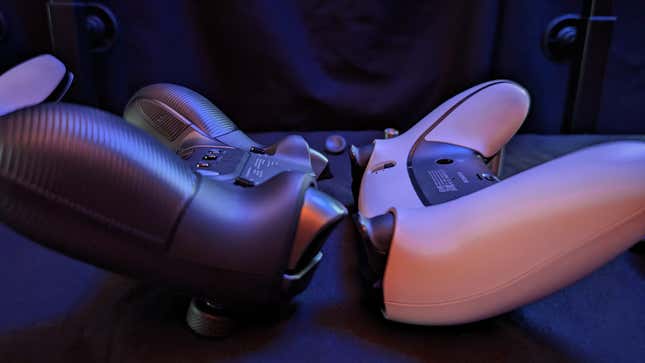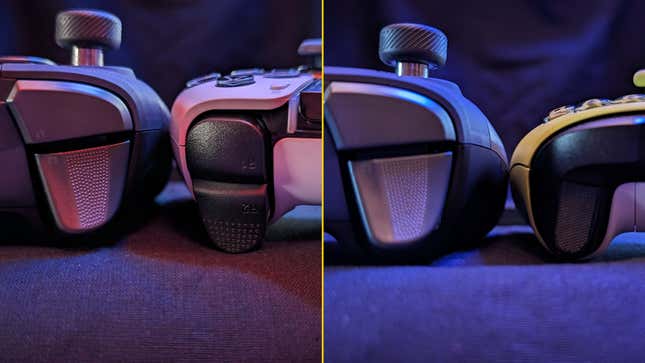The design of the video game controller as we know it has remained largely the same over the past 20 years: a D-pad, two analog sticks, four face buttons and four shoulder buttons. It ranges from the DualShock of the first PlayStation to the DualSense of the modern PS5 to various Xbox and Nintendo controllers.
In recent years there has been a surge in “elite” and “pro” controllers that promise additional performance, especially in competitive gaming where you have an advantage over your opponents by keeping your thumbs on as often as possible Analog sticks retained. The Nacon Revolution 5 Pro controller for PS5, PS4 and PC is a relatively new contender in this market, promising four rear-positioned buttons and, perhaps most tantalizingly, thumbsticks that never drift.
As a hybrid PlayStation and PC gamepad, the Revolution 5 Pro is flanked by offerings from Sony and Microsoft. Priced at $200, it competes directly with Sony’s professional controller, the DualSense Edge (which is the same price). On the PC side, the Xbox Elite Controller is about $30 less. However, none of the Revolution 5’s first-party competitors offer drift-free analog sticks (although you can purchase third-party drift-free analog sticks for the DualSense Edge that fit right in).
But while its Driftless technology makes a solid case for adding it to your gaming arsenal, the Nacon Revolution 5 Pro is a little too uncomfortable to use in my experience.
Wonderful on paper, but painful in the hands
The Revolution 5 Pro has a ton of impressive specs: four dedicated buttons on the back that can be assigned on the device using a hotkey combination and four different profiles; two interchangeable D-pads (a traditional T-shaped one and a “satellite dish” variety common on Xbox controllers); three pairs of weights that you can insert into the controller to change its weight; interchangeable joystick rings in two different thicknesses and six interchangeable joystick heads; Wireless support for both PC and PlayStation (you’ll have to forego a USB port if you want to use it wirelessly on PlayStation) and two degrees of adjustable shutter range for minimum and full depth, as well as full gyro support for PlayStation.

What causes drift?
Controller drift, a modern gremlin of gaming technology, is the result of wear or buildup inside the average analog stick Potentiometer Tech. Almost all controllers that use potentiometers will sooner or later be affected by this. Like the Sega Saturn and Dreamcast controllers before it, the Revolution 5 Pro also features “Hall effect“Analog sticks that use magnets for contactless signal communication. The result? There are no physical parts inside that rub against each other, so these thumbsticks are not subject to the same wear and tear as potentiometers.
The Revolution 5 features an asymmetrical thumbstick layout, which may annoy you as a PlayStation purist – I prefer symmetrical layouts, but I was excited to try it out. Unfortunately, despite its wonderful list of features, this controller and I just never got along.
The Revolution 5’s ergonomic problems lie in two places: the shoulder buttons and the curve under L2/R2 where your middle or ring finger rests. As for the second point, the controller seems to either sit forward in my hands or tilt backwards, so I find myself fumbling with it a lot while playing. I suspect that this has led to a perceived deterioration in gameplay performance for me in such shooters Halo Infinite on the PC – I was too distracted trying to hold the controller well in my hands. Most worryingly, long sessions would numb or cramp my hands, which is simply not the case with other, more ergonomic controllers.

For the record, I’m an avid lover of the traditional Xbox “Duke” controller and often play wide-neck, baritone 8-string guitars when I’m not playing. Therefore, hand size and large objects are not a problem for me.
And the shape and positioning of the shoulder buttons make the Revolution 5 feel like it’s not sure whether it’s supposed to be a PlayStation or Xbox controller. When the Xbox 360 launched in 2005, the original Xbox’s “black and white” buttons were moved to the shoulders. However, this was done as a “bumper”, which differentiated it from the PlayStation controller in a way that encouraged operating it with the sides of the index finger. The advantage of this is that you can keep your index or “trigger” fingers on the… well, the triggers. This makes it a great design for shooters.

Xbox controllers, especially modern ones, feature a gentle concave notch in the bumpers that conforms to the upper shape of the tip of your index finger, or the “Terminal phalanxHowever, PlayStation controllers traditionally require players to have a bifurcated two-finger grip, although modern DualShock 4 and DualSense controllers on the L1/R1 are curved just enough that you can get away with a grip similar to what you would on an Xbox use.
However, the Revolution 5 has neither the concave curve of the Xbox’s bumpers nor the gentle inward slope of the DualSense. The L1/R1 buttons end at a rigid 90-degree angle that’s just not suitable for a standard Xbox grip. But since it’s shaped more like an Xbox controller in the shoulder area, it doesn’t feel comfortable to use the PlayStation’s bifurcated two-finger grip either.
This difference caused me to keep changing my grip throughout the game. I suspect this was another reason for my performance gloriole Things got worse: I was too distracted trying to keep this otherwise pretty feature-rich controller comfortable and reliable.
Ultimately, however, the integrated Hall effect thumbsticks should not be underestimated. These days it seems like controller drift is getting worse with every new generation, so it’s definitely tempting to spend a chunk of money on a controller that will outlast the purchase of two or three controllers
A solution for aging consoles?
The fact that the Revolution 5 uses Driftless Hall Effect technology makes me see its utility as a way to extend the life of a PS4, the DualShock 4s of which will become more difficult to secure over time. The same goes for the PS5 as it gets older. Yes, there are other ways controllers can develop problems and fail (my gloriously green Xbox wireless controller has been seeing the D-pad randomly actuate itself lately), but drift remains one of the most insidious and difficult to manage problems to be resolved.
Despite the issues I had with comfort (or lack thereof), I think the Revolution 5 Pro is worth it as a long-term purchase – even if that’s still pretty steep at $200. Of course, you can replace the DualSense Edge’s thumbsticks for the same price, extending its lifespan, but that increases the cost.
The Revolution 5 Pro impresses on paper and feels premium – something that is unfortunately marred by some inconvenient design decisions. There’s good reason to think about grabbing one, as it offers extra customization options, four buttons on the back, and great thumbsticks, but you might want to hold one in your hand before buying to see if it’s in the truest sense the word fits well.



